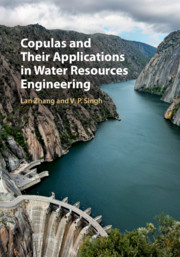Book contents
- Copulas and Their Applications in Water Resources Engineering
- Copulas and Their Applications in Water Resources Engineering
- Copyright page
- Dedication
- Contents
- Preface
- Acknowledgments
- Part One Theory
- 1 Introduction
- 2 Preliminaries
- 3 Copulas and Their Properties
- 4 Symmetric Archimedean Copulas
- 5 Asymmetric Copulas
- 6 Plackett Copula
- 7 Non-Archimedean Copulas
- 8 Entropic Copulas
- 9 Copulas in Time Series Analysis
- Part Two Applications
- Index
- References
9 - Copulas in Time Series Analysis
from Part One - Theory
Published online by Cambridge University Press: 03 January 2019
- Copulas and Their Applications in Water Resources Engineering
- Copulas and Their Applications in Water Resources Engineering
- Copyright page
- Dedication
- Contents
- Preface
- Acknowledgments
- Part One Theory
- 1 Introduction
- 2 Preliminaries
- 3 Copulas and Their Properties
- 4 Symmetric Archimedean Copulas
- 5 Asymmetric Copulas
- 6 Plackett Copula
- 7 Non-Archimedean Copulas
- 8 Entropic Copulas
- 9 Copulas in Time Series Analysis
- Part Two Applications
- Index
- References
Summary
In previous chapters, we have mainly discussed copula models for bivariate/multivariate random variables. Now we ask two other questions that usually arise in hydrology and water resources engineering. Can we use the stochastic approach to predict streamflow at a downstream location using streamflow at the upstream location? If streamflow is time dependent, then it cannot be considered as a random variable as is done in frequency analysis. Can we model the temporal dependence of an at-site streamflow sequence (e.g., monthly streamflow) more robustly than with the classical time series and Markov modeling approach (e.g., modeling the nonlinearity of time series freely)? This chapter attempts to address these questions and introduces how to model a time series with the use of copula approach.
Information
- Type
- Chapter
- Information
- Copulas and their Applications in Water Resources Engineering , pp. 329 - 364Publisher: Cambridge University PressPrint publication year: 2019
